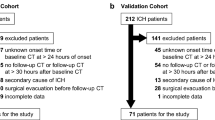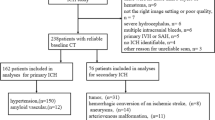Abstract
Purpose
The objective of this study was to predict hematoma expansion (HE) by radiomic models based on different machine learning methods and determine the best radiomic model through the comparison.
Method
A total of 108 patients with intracerebral hemorrhage were retrospectively evaluated. Images of baseline non-contrast computed tomography (NCCT) and follow-up NCCT scan within 24 h were retrospectively reviewed. An HE was defined as a volume increase of more than 33% or an increase greater than 12.5 mL from the volume of the baseline NCCT. Texture parameters of the baseline NCCT images were selected by the least absolute shrinkage and selection operator (LASSO) regression. We used support vector machine (SVM), decision tree (DT), conditional inference trees (CIT), random forest (RF), k‑nearest neighbors (KNN), back-propagation neural network (BPNet) and Bayes to build models. Receiver operating characteristic (ROC) analysis and decision curve analysis (DCA) was performed and compared among models.
Results
Every model had a relatively high AUC (all > 0.75), SVM and KNN had the highest AUC of 0.91. There were significant differences between SVM and CIT (Z > 2.266, p = 0.02345), KNN and CIT (Z = 2.4834, p = 0.01301), RF and CIT (Z = 2.6956, p = 0.007027), KNN and BPNet (Z = 2.0122, p = 0.0442), RF and BPNet (Z = 1.9793, p = 0.04778). There was no significant difference among SVM, DT, RF, KNN and Bayes (p > 0.05). The SVM obtained the largest net benefit when the threshold probability was less than 0.33, while KNN obtained the largest net benefit when the threshold probability was greater than 0.33. Combined with ROC and DCA, SVM and KNN performed better in all the models for predicting HE.
Conclusion
Radiomic models based on different machine learning methods can be used to predict HE and the models generated by SVM and KNN performed best.





Similar content being viewed by others
Abbreviations
- AUC:
-
Area under the ROC curves
- BPNet:
-
Back-propagation neural network
- CIT:
-
Conditional inference trees CIT
- CTA:
-
Computed tomography angiography
- DCA:
-
Decision curve analysis
- DT:
-
Decision tree
- HE:
-
Hematoma expansion
- ICC:
-
Intraclass correlation coefficient
- ICH:
-
Intracerebral hemorrhage
- KNN:
-
K‑nearest neighbors
- LASSO:
-
Least absolute shrinkage and selection operator
- NCCT:
-
Non-contrast computed tomography
- RF:
-
Random forest
- ROC:
-
Receiver operating characteristic
- ROI:
-
Region of interest
- SVM:
-
Support vector machine
- U:
-
Uniformity
- V:
-
Variance
References
Falcone GJ, Biffi A, Brouwers HB, Anderson CD, Battey TW, Ayres AM, Vashkevich A, Schwab K, Rost NS, Goldstein JN, Viswanathan A, Greenberg SM, Rosand J. Predictors of hematoma volume in deep and lobar supratentorial intracerebral hemorrhage. JAMA Neurol. 2013;70:988–94.
Qureshi AI, Tuhrim S, Broderick JP, Batjer HH, Hondo H, Hanley DF. Spontaneous intracerebral hemorrhage. N Engl J Med. 2001;344:1450–60.
van Asch CJ, Luitse MJ, Rinkel GJ, van der Tweel I, Algra A, Klijn CJ. Incidence, case fatality, and functional outcome of intracerebral haemorrhage over time, according to age, sex, and ethnic origin: a systematic review and meta-analysis. Lancet Neurol. 2010;9:167–76.
Brouwers HB, Chang Y, Falcone GJ, Cai X, Ayres AM, Battey TW, Vashkevich A, McNamara KA, Valant V, Schwab K, Orzell SC, Bresette LM, Feske SK, Rost NS, Romero JM, Viswanathan A, Chou SH, Greenberg SM, Rosand J, Goldstein JN. Predicting hematoma expansion after primary intracerebral hemorrhage. JAMA Neurol. 2014;71:158–64.
Delcourt C, Huang Y, Arima H, Chalmers J, Davis SM, Heeley EL, Wang J, Parsons MW, Liu G, Anderson CS; INTERACT1 Investigators. Hematoma growth and outcomes in intracerebral hemorrhage: the INTERACT1 study. Neurology. 2012;79:314–9.
Dowlatshahi D, Demchuk AM, Flaherty ML, Ali M, Lyden PL, Smith EE; VISTA Collaboration. Defining hematoma expansion in intracerebral hemorrhage: relationship with patient outcomes. Neurology. 2011;76:1238–44.
Balami JS, Buchan AM. Complications of intracerebral haemorrhage. Lancet Neurol. 2012;11:101–18.
Brouwers HB, Chang Y, Falcone GJ, Cai X, Ayres AM, Battey TW, Vashkevich A, McNamara KA, Valant V, Schwab K, Orzell SC, Bresette LM, Feske SK, Rost NS, Romero JM, Viswanathan A, Chou SH, Greenberg SM, Rosand J, Goldstein JN. Predicting hematoma expansion after primary intracerebral hemorrhage. JAMA Neurol. 2014;71:158–64.
Li Q, Liu QJ, Yang WS, Wang XC, Zhao LB, Xiong X, Li R, Cao D, Zhu D, Wei X, Xie P. Island sign: An imaging predictor for early hematoma expansion and poor outcome in patients with intracerebral hemorrhage. Stroke. 2017;48:3019–25.
Li Q, Zhang G, Huang YJ, Dong MX, Lv FJ, Wei X, Chen JJ, Zhang LJ, Qin XY, Xie P. Blend sign on computed tomography: Novel and reliable predictor for early hematoma growth in patients with intracerebral hemorrhage. Stroke. 2015;46:2119–23.
Sporns PB, Schwake M, Schmidt R, Kemmling A, Minnerup J, Schwindt W, Cnyrim C, Zoubi T, Heindel W, Niederstadt T, Hanning U. Computed tomographic blend sign is associated with computed tomographic angiography spot sign and predicts secondary neurological deterioration after intracerebral hemorrhage. Stroke. 2017;48:131–5.
Li Q, Zhang G, Xiong X, Wang XC, Yang WS, Li KW, Wei X, Xie P. Black hole sign: Novel imaging marker that predicts hematoma growth in patients with intracerebral hemorrhage. Stroke. 2016;47:1777–81.
Ng D, Churilov L, Mitchell P, Dowling R, Yan B. The CT swirl sign is associated with hematoma expansion in intracerebral hemorrhage. AJNR Am J Neuroradiol. 2018;39:232–7.
Demchuk AM, Dowlatshahi D, Rodriguez-Luna D, Molina CA, Blas YS, Dzialowski I, Kobayashi A, Boulanger JM, Lum C, Gubitz G, Padma V, Roy J, Kase CS, Kosior J, Bhatia R, Tymchuk S, Subramaniam S, Gladstone DJ, Hill MD, Aviv RI; PREDICT/Sunnybrook ICH CTA study group. Prediction of haematoma growth and outcome in patients with intracerebral haemorrhage using the CT-angiography spot sign (PREDICT): a prospective observational study. Lancet Neurol. 2012;11:307–14. Erratum in: Lancet Neurol. 2012;11:483.
Orito K, Hirohata M, Nakamura Y, Takeshige N, Aoki T, Hattori G, Sakata K, Abe T, Uchiyama Y, Sakamoto T, Morioka M. Leakage sign for primary intracerebral hemorrhage: A novel predictor of hematoma growth. Stroke. 2016;47:958–63.
Peng WJ, Reis C, Reis H, Zhang J, Yang J. Predictive value of CTA spot sign on hematoma expansion in intracerebral hemorrhage patients. Biomed Res Int. 2017;2017:4137210.
Boulouis G, Morotti A, Charidimou A, Dowlatshahi D, Goldstein JN. Noncontrast computed tomography markers of intracerebral hemorrhage expansion. Stroke. 2017;48:1120–5.
Gillies RJ, Kinahan PE, Hricak H. Radiomics: Images are more than pictures, they are data. Radiology. 2016;278:563–77.
Kumar V, Gu Y, Basu S, Berglund A, Eschrich SA, Schabath MB, Forster K, Aerts HJ, Dekker A, Fenstermacher D, Goldgof DB, Hall LO, Lambin P, Balagurunathan Y, Gatenby RA, Gillies RJ. Radiomics: the process and the challenges. Magn Reson Imaging. 2012;30:1234–48.
Lambin P, Rios-Velazquez E, Leijenaar R, Carvalho S, van Stiphout RG, Granton P, Zegers CM, Gillies R, Boellard R, Dekker A, Aerts HJ. Radiomics: extracting more information from medical images using advanced feature analysis. Eur J Cancer. 2012;48:441–6.
Shen Q, Shan Y, Hu Z, Chen W, Yang B, Han J, Huang Y, Xu W, Feng Z. Quantitative parameters of CT texture analysis as potential markersfor early prediction of spontaneous intracranial hemorrhage enlargement. Eur Radiol. 2018;28:4389–96.
Xie H, Ma S, Wang X, Zhang X. Noncontrast computer tomography-based radiomics model for predicting intracerebral hemorrhage expansion: preliminary findings and comparison with conventional radiological model. Eur Radiol. 2020;30:87–98.
Ma C, Zhang Y, Niyazi T, Wei J, Guocai G, Liu J, Liang S, Liang F, Yan P, Wang K, Jiang C. Radiomics for predicting hematoma expansion in patients with hypertensive intraparenchymal hematomas. Eur J Radiol. 2019;115:10–5.
Koo TK, Li MY. A guideline of selecting and reporting intraclass correlation coefficients for reliability research. J Chiropr Med. 2016;15:155–63. Erratum in: J Chiropr Med. 2017;16:346.
DeLong ER, DeLong DM, Clarke-Pearson DL. Comparing the areas under two or more correlated receiver operating characteristic curves: a nonparametric approach. Biometrics. 1988;44:837–45.
Vickers AJ, Elkin EB. Decision curve analysis: a novel method for evaluating prediction models. Med Decis Making. 2006;26:565–74.
Rousson V, Zumbrunn T. Decision curve analysis revisited: overall net benefit, relationships to ROC curve analysis, and application to case-control studies. BMC Med Inform Decis Mak. 2011;11:45.
Xu X, Zhang J, Yang K, Wang Q, Xu B, Chen X. Accuracy of spot sign in predicting hematoma expansion and clinical outcome: A meta-analysis. Medicine (Baltimore). 2018;97:e11945.
Barras CD, Tress BM, Christensen S, Collins M, Desmond PM, Skolnick BE, Mayer SA, Davis SM; Recombinant Activated Factor VII Intracerebral Hemorrhage Trial Investigators. Quantitative CT densitometry for predicting intracerebral hemorrhage growth. AJNR Am J Neuroradiol. 2013;34:1139–44.
Ng F, Kozarski R, Ganeshan B, Goh V. Assessment of tumor heterogeneity by CT texture analysis: can the largest cross-sectional area be used as an alternative to whole tumor analysis? Eur J Radiol. 2013;82:342–8.
Author information
Authors and Affiliations
Corresponding author
Ethics declarations
Conflict of interest
Chongfeng Duan, Fang Liu, Song Gao, Jiping Zhao, Lei Niu, Nan Li, Song Liu, Gang Wang, Xiaoming Zhou, Yande Ren, Wenjian Xu and Xuejun Liu declare that they have no competing interests.
Rights and permissions
About this article
Cite this article
Duan, C., Liu, F., Gao, S. et al. Comparison of Radiomic Models Based on Different Machine Learning Methods for Predicting Intracerebral Hemorrhage Expansion. Clin Neuroradiol 32, 215–223 (2022). https://doi.org/10.1007/s00062-021-01040-2
Received:
Accepted:
Published:
Issue Date:
DOI: https://doi.org/10.1007/s00062-021-01040-2




